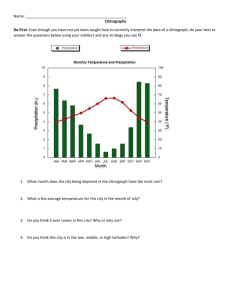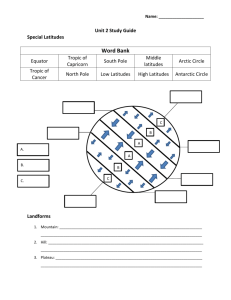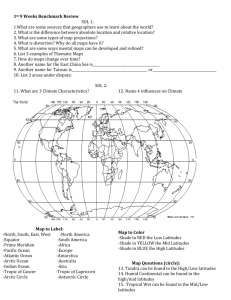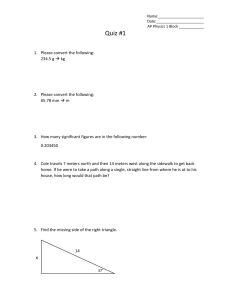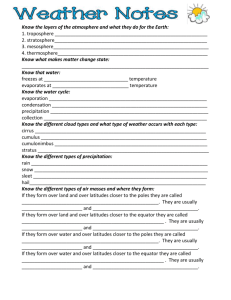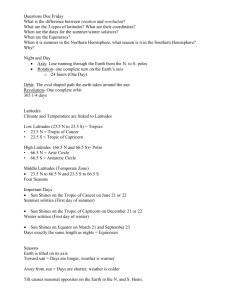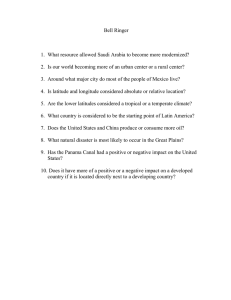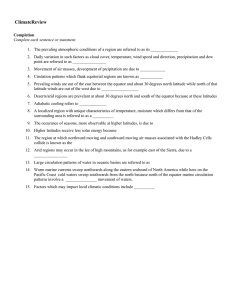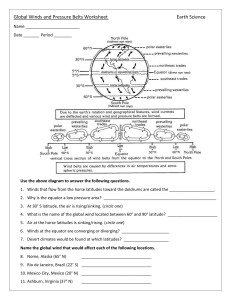Ocean Temperature Profiles: Latitude & Depth Worksheet
advertisement
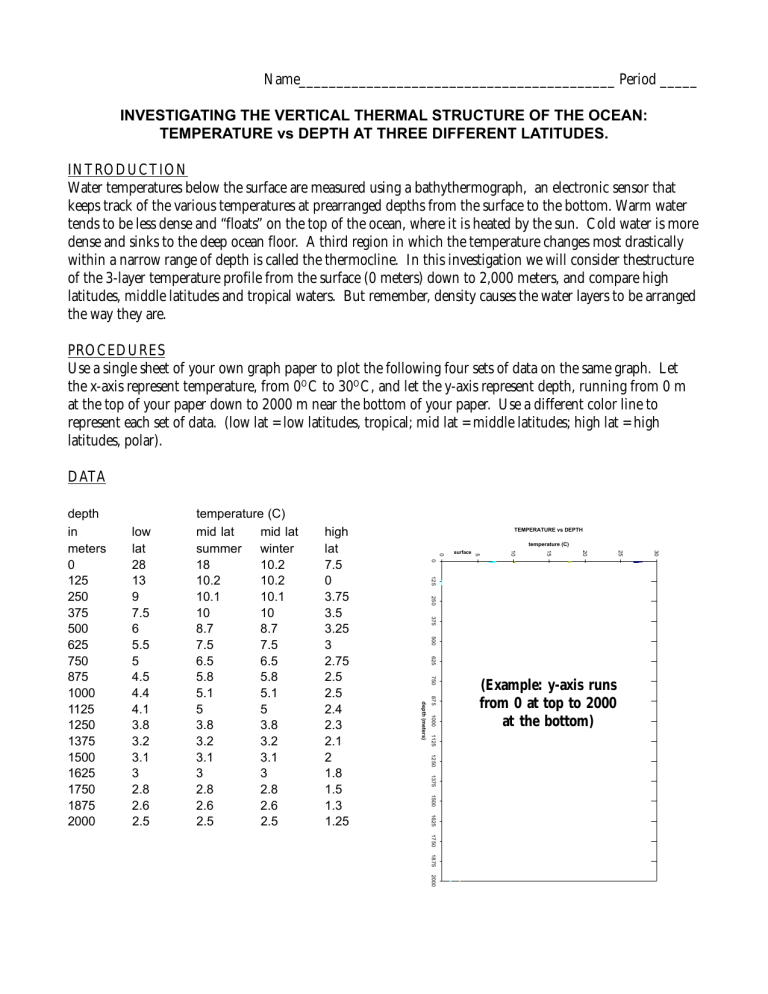
Name__________________________________________ Period _____ INVESTIGATING THE VERTICAL THERMAL STRUCTURE OF THE OCEAN: TEMPERATURE vs DEPTH AT THREE DIFFERENT LATITUDES. INTRODUCTION Water temperatures below the surface are measured using a bathythermograph, an electronic sensor that keeps track of the various temperatures at prearranged depths from the surface to the bottom. Warm water tends to be less dense and “floats” on the top of the ocean, where it is heated by the sun. Cold water is more dense and sinks to the deep ocean floor. A third region in which the temperature changes most drastically within a narrow range of depth is called the thermocline. In this investigation we will consider thestructure of the 3-layer temperature profile from the surface (0 meters) down to 2,000 meters, and compare high latitudes, middle latitudes and tropical waters. But remember, density causes the water layers to be arranged the way they are. PROCEDURES Use a single sheet of your own graph paper to plot the following four sets of data on the same graph. Let the x-axis represent temperature, from 0OC to 30OC, and let the y-axis represent depth, running from 0 m at the top of your paper down to 2000 m near the bottom of your paper. Use a different color line to represent each set of data. (low lat = low latitudes, tropical; mid lat = middle latitudes; high lat = high latitudes, polar). DATA TEMPERATURE vs DEPTH temperature (C) tropical polar summer mid latitudes 375 500 625 750 1000 1125 depth (meters) 875 (Example: y-axis runs from 0 at top to 2000 at the bottom) 30 25 20 15 10 surface 5 250 1250 1375 1500 1625 high lat 7.5 0 3.75 3.5 3.25 3 2.75 2.5 2.5 2.4 2.3 2.1 2 1.8 1.5 1.3 1.25 125 temperature (C) mid lat mid lat summer winter 18 10.2 10.2 10.2 10.1 10.1 10 10 8.7 8.7 7.5 7.5 6.5 6.5 5.8 5.8 5.1 5.1 5 5 3.8 3.8 3.2 3.2 3.1 3.1 3 3 2.8 2.8 2.6 2.6 2.5 2.5 0 low lat 28 13 9 7.5 6 5.5 5 4.5 4.4 4.1 3.8 3.2 3.1 3 2.8 2.6 2.5 0 depth in meters 0 125 250 375 500 625 750 875 1000 1125 1250 1375 1500 1625 1750 1875 2000 1750 1875 2000 ANALYSIS OF DATA 1. Describe the general shape of the temperature depth curve: a) at low latitudes c) at mid latitudes in winter b) at mid latitudes in summer d) at high latitudes 2. (a) Label and (use arrows) the three temperature layers for each location: Surface Layer, Thermocline, Deep and Bottom Layer. (b) Name the locations for which this task is difficult or nearly impossible. 3. Which two locations indicated by your graphs might require the use of a wetsuit (or drysuit) to prevent hypothermia when swimming in the ocean? Why? 4. Approximately where (at what depth) is the primary thermocline: a) at low latitudes c) at mid latitudes in winter b) at mid latitudes in summer d) at high latitudes 5. Calculate the rate at which the overall temperature drops in OC for each 100 meters, within the first 125 meters of the water column: a) at low latitudes c) at mid latitudes in winter b) at mid latitudes in summer d) at high latitudes [Hint: subtract the temperature at 125m from the surface temperature, then divide by 125. Multiply your answer by 100]. 6. Which regions show: (a) the most rapid temperature decline, and (b) the slowest temperature decline, within the upper 125 meters of the ocean? 7. Calculate the rate at which the overall temperature drops in OC per 100 meters, between 750 and 1,750 meters (a 1,000 meter interval) in the water column: a) at low latitudes c) at mid latitudes in winter b) at mid latitudes in summer d) at high latitudes [Hint: subtract the temperature at 1,750 meters from the temperature at 750 meters, then divide by 1,000. Multiply your answer by 100]. 6. Which regions (a) show the most rapid temperature decline, and (b) the slowest temperature decline, below 750 meters in the ocean? 8. Extrapolate the data as depicted on your temperature profile graphs and predict the water temperature at a depth of 3000 m: a) at low latitudes c) at mid latitudes in winter b) at mid latitudes in summer d) at high latitudes 9. Write a short summary explaining what happens to the water temperature profile from the surface to 125 meters at various latitudes. 10. Write a short summary explaining what happens to the water temperature profile below 750 meters at various latitudes. 11- (Outside research) Notice that the temperature depth profile for high latitudes shows a drastic decline in temperature at an approximate depth of 125 meters, then increases in temperature down to 250 meters, beyond which there is a continual and gradual decline. This “hook” in the profile which represents a very cold water layer sandwiched between warmer surface, and warmer deeper water, is very unusual. Knowing that water temperatures for layers according to their density, explain the presence of this “hook” in the graph. [Hint: the “hook” is known as a dicothermal layer]. TEMPERATURE vs DEPTH temperature (C) 0 125 tropical 250 polar winter summer 375 mid latitudes 30 25 20 15 5 0 10 surface 500 625 750 875 1000 1125 depth (meters) 1250 1375 1500 1625 1750 TEACHER’S GUIDE: TEMPERATURE vs DEPTH temperature (C) 30 25 20 15 5 0 10 surface 0 125 tropical 250 polar winter summer 375 mid latitudes 500 625 750 1000 1125 depth (meters) 875 Most of the major thermoclines, if present, occur fairly shallow, just below the surface, no matter the latitude. The deep and bottom waters of all oceans and all latitudes are uniformly cold (there are no diurnal cycles or seasonal changes in the deep). The most well developed thermoclines are at low latitudes and mid latitudes during the summer, given the transition from warm surface to uniformly cold deep and bottom water. Rates of temperature decline in OC / meter: 1250 1375 1500 1625 Upper 125 meters; High Lat 0 - 7.5 / 125 = -0.0600*100= Mid Sum 10.2 - 18 / 125 = -0.0624*100= Mid Win 0.0 - 0.0 /125 = +/- 0.00*100= Low Lat 13 - 28 / 125 = - 0.1440* 100= -6.0 OC / 100 meters -6.24 OC / 100 meters 0.00 OC / 100 meters -1.44 OC / 100 meters Below 750 meters: High Lat 1.5 - 2.75 / 125 = - 0.00125*100= Mid Sum 2.8 - 6.5 / 125 = - 0.02960 *100= Mid Win 2.8 - 6.5 / 125 = - 0.02960*100= Low Lat 2.8 - 5 / 125 = -0.01760*100= -0.125 OC / 100 meters -2.96 OC / 100 meters -2.96 OC / 100 meters -1.76 OC / 100 meters 1750 The dicothermal layer : A vertical ocean layer sometimes found in high northern latitudes. It is a cold (as low as -1.6 C) layer from 50 to 100 m sandwiched between a warm surface and a warm deeper layer. The stability of this discontinuity is maintained because the warmer surface waters are of very low salinity, and the warmer deep waters are much higher salinty, than the dicothermal layer waters.
